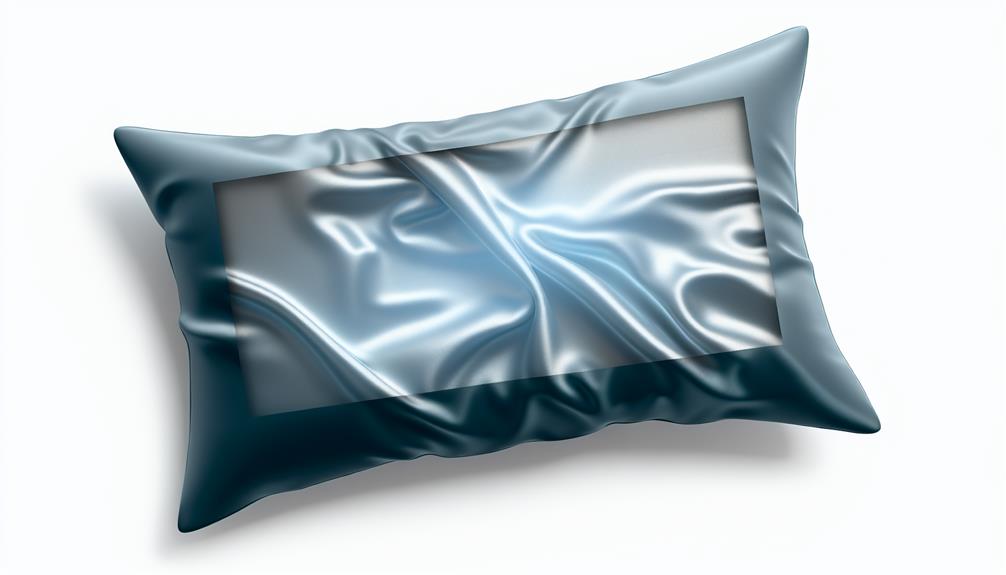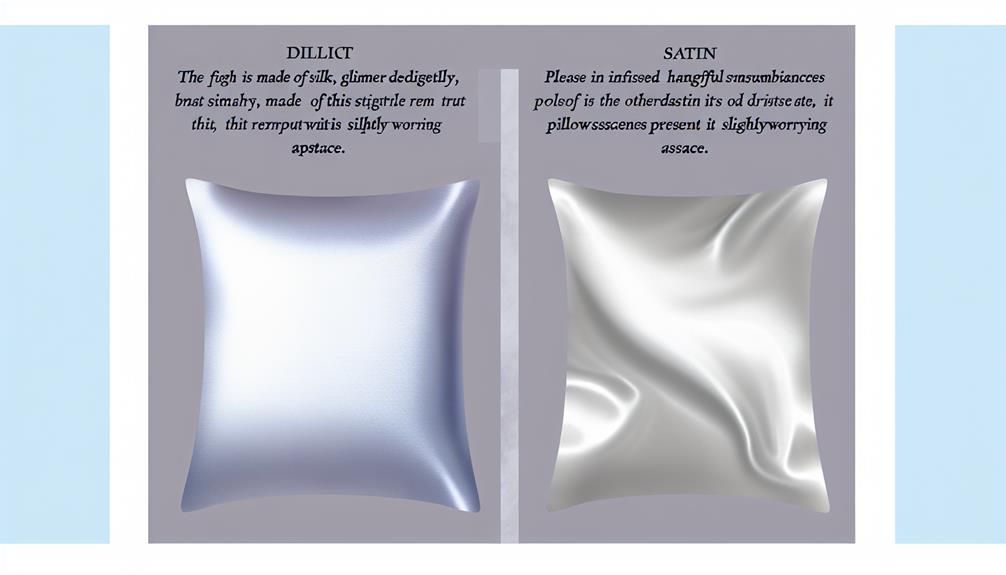In a world where satin reigns supreme, it’s time to lift the veil on its hidden secrets of toxins in satin. Like a wolf in sheep’s clothing, this seemingly luxurious fabric may not be as innocent as it appears.
We have uncovered a web of hidden toxins lurking within satin’s silky embrace, and it’s essential for you to know what it’s made of. From harmful chemicals that can wreak havoc on your health to the potential risks associated with prolonged exposure, the truth behind satin’s allure is anything but glamorous.
Brace yourself as we peel back the layers and reveal the dark side of this popular fabric, leaving you with a newfound awareness and a burning desire for safer alternatives.
Potential Hazards of Toxins in Satin

Satin, despite its allure and perceived benefits, harbors hidden toxins that pose potential hazards to our health and well-being. This synthetic fabric, often chosen for its durability and easy draping, may contain harmful chemicals such as Formaldehyde, Azo dyes, and heavy metals like cadmium or mercury. These toxins have been associated with an increased risk of cancer and other health issues.
Additionally, satin can tug at our hair and irritate our skin, causing discomfort and potential skin problems. It’s crucial to be aware of the chemicals that can be found in satin fabric, as they can bioaccumulate in our bodies and lead to various health problems.
To stay safe, we should consider switching to natural materials like cotton or silk, which offer their own unique benefits and are free from harmful toxins.
Composition and Types of Satin
When exploring the composition and types of satin, it becomes apparent that this artificial fabric is created by weaving polyester, rayon, or nylon fibers into a luxurious satin weave. Here are three key points to consider:
- Antique Satin: This type of satin weave has a glossy, smooth surface and is often used for elegant eveningwear or upholstery.
- Slipper Satin: Known for its lustrous and lightweight nature, slipper satin is commonly used for lingerie, nightgowns, and bridal wear.
- Polyester Satin: This type of satin is made from synthetic polyester fibers and is often chosen for its affordability, durability, and resistance to wrinkles.
Understanding the composition and types of satin allows us to make informed choices when it comes to our clothing and bedding.
Liberation comes from knowing what we wear and sleep on, empowering us to make healthier and more conscious decisions.
Chemicals Commonly Found in Satin Fabric

With its luxurious texture and glossy sheen, satin fabric is a popular choice for clothing and bedding, but it’s important to be aware of the hidden toxins that can often be found lurking within its fibers. Toxins in Satin fabric can contain various chemicals depending on the specific finish applied. These chemicals can pose serious health risks, including an increased risk of cancer or other health issues. To give you a better understanding, here are some common chemicals that can be found in satin fabric:
| Chemical | Potential Health Risks |
|---|---|
| Formaldehyde | Respiratory issues, skin irritation |
| Azo dyes | Allergic reactions, skin irritation |
| Heavy metals | Neurological damage, organ toxicity |
| Organotin compounds | Hormonal disruption, reproductive issues |
| Chlorobenzenes | Liver damage, respiratory problems |
It’s crucial to be informed about these toxins and their potential impact on our health. By opting for natural materials like cotton, silk, leather, or wool, we can make safer choices for our clothing and bedding.
Health Risks Associated WithToxins in Satin
Exposure to the toxins present in satin fabric can pose significant health risks, ranging from respiratory issues and skin irritation to neurological damage and reproductive issues. Here are three health risks associated with satin toxins:
- Respiratory issues: Satin fabric can release harmful chemicals into the air, which can be inhaled and cause respiratory problems such as coughing, wheezing, and difficulty breathing. This is especially concerning for individuals with pre-existing respiratory conditions like asthma.
- Skin irritation: Satin fabric can irritate the skin, leading to rashes, redness, and itching. The chemicals present in satin, such as formaldehyde and azo dyes, can be particularly harsh on sensitive skin, causing discomfort and potential long-term damage.
- Reproductive issues: Some chemicals found in satin, like heavy metals and organotin compounds, have been linked to reproductive problems. These toxins can interfere with hormone levels, disrupt the endocrine system, and increase the risk of infertility or complications during pregnancy.
It is crucial to be aware of these health risks associated withToxins in Satin and consider alternative fabric options that are safer for our well-being.
Safety Measures for Avoiding Satin Toxins

Now let’s explore some essential safety measures to protect ourselves from the toxins present in satin fabric.
When it comes to avoiding satin toxins, there are a few key steps we can take.
First, it’s important to look for products with third-party certifications like the OEKO-TEX Standard 100. This ensures that the satin is free from harmful chemicals.
Additionally, consider switching to natural materials like cotton, silk, leather, or wool for bed linens and clothing. Silk, in particular, is recommended as a healthier alternative to satin. It offers benefits such as hypoallergenic properties, breathability, anti-aging effects, antibacterial properties, and bug resistance.
Brands like Ubersilk use 100% natural mulberry silk and have OEKO-TEX certification, providing assurance of safety and non-toxicity.
Importance of Third-Party Certifications
By seeking out products with third-party certifications like the OEKO-TEX Standard 100, we can ensure that the satin we purchase is free from harmful chemicals, prioritizing our health and well-being. Here’s why third-party certifications are important:
- Independent Verification:
Third-party certifications provide an unbiased assessment of a product’s safety. They’re conducted by independent organizations with expertise in evaluating the presence of harmful substances in textiles. This means we can trust that the satin we buy has been thoroughly tested and meets strict standards for chemical content.
- Transparent Supply Chain:
Certifications require transparency in the supply chain, ensuring that manufacturers and suppliers adhere to responsible practices. This helps us make informed choices about the products we bring into our homes and wear on our bodies.
- Peace of Mind:
With third-party certifications, we can have peace of mind knowing that the satin we choose is free from harmful toxins of satin. This allows us to enjoy the luxurious feel and beauty of satin without compromising our health.
Benefits of Switching to Natural Materials

Switching to natural materials offers a multitude of benefits for our well-being and the environment.
Natural materials like cotton, silk, leather, or wool aren’t only safer for our health but also more sustainable. Cotton, for example, is a breathable and hypoallergenic fabric that’s gentle on the skin. Silk, on the other hand, is known for its luxurious feel, anti-aging effects, and antibacterial properties.
Choosing natural materials means avoiding harmful toxins of satin which can have detrimental effects on our bodies.
By making the switch, we not only protect our health but also contribute to a cleaner and greener planet.
Silk as a Healthier Alternative to Satin
As we explore the topic of natural materials and their benefits, let’s now turn our attention to silk, a healthier alternative to satin.
Here are three reasons why silk is a wise choice:
- Hypoallergenic properties: Silk is naturally hypoallergenic, making it ideal for those with sensitive skin or allergies. Unlike satin, which can irritate the skin, silk is gentle and soothing, promoting a sense of comfort and liberation.
- Breathability: Silk allows air to circulate freely, keeping you cool and dry throughout the night. This breathability helps regulate body temperature and prevents sweating, providing a liberating and refreshing sleep experience.
- Anti-aging effects: Silk’s smooth and soft texture isn’t only luxurious to the touch but also beneficial for your skin. Its natural proteins and amino acids help retain moisture and prevent wrinkles, giving you a youthful and radiant appearance.
Choosing Between Silk and Satin Pillowcases

When it comes to choosing the best pillowcase for your health and well-being, considering the differences between silk and satin is essential.
Silk pillowcases are recommended as the healthier choice due to their durability, glossy surface, luxurious feel, and absence of hazardous toxins found in synthetic materials like satin.
While silk pillowcases may require hand-washing, Ubersilk offers machine-washable options with care instructions. Ubersilk products use 100% natural mulberry silk and have OEKO-TEX certification, providing assurance of safety and non-toxicity.
It’s important to note that Ubersilk emphasizes the difference between synthetic satin and their natural silk products, highlighting the absence of harmful chemicals in their silk pillowcases.
Choosing silk pillowcases is a healthier choice for your well-being.
Ubersilk Natural Silk Products and Certification
Ubersilk takes pride in offering a range of natural silk products that prioritize both safety and quality. Our commitment to providing safe and non-toxic options is reflected in our certification from OEKO-TEX, a third-party organization that ensures our products are free from harmful chemicals.
Here are three reasons why Ubersilk natural silk products and certification are important:
- Health and well-being: By choosing Ubersilk natural silk products, you can rest easy knowing that you aren’t exposing yourself to hazardous toxins found in synthetic materials like satin. Our OEKO-TEX certification guarantees that our silk pillowcases are safe, eco-friendly, and free from harmful chemicals.
- Peace of mind: With Ubersilk natural silk products, you can enjoy the luxurious feel and benefits of silk without worrying about the potential health risks associated with satin. Our certification provides assurance that our products meet rigorous safety standards, allowing you to sleep soundly and confidently.
- Sustainable and ethical choice: Ubersilk commitment to using 100% natural mulberry silk aligns with our desire for liberation. Silk is a sustainable and renewable resource, and our products are produced in an ethical manner. By choosing Ubersilk , you aren’t only prioritizing your health but also supporting a brand that values sustainability and ethical practices.
Frequently Asked Questions
Are There Any Safe Chemicals Used in the Production of Satin Fabric?
Yes, there are safe chemicals used in the production of satin fabric.
While satin can contain harmful toxins, certain chemicals are necessary for specific functions, such as flame retardants in evening gowns.
However, it’s important to note that these chemicals can still have adverse effects on our health.
To stay safe, look for products with safety certifications like the OEKO-TEX Standard 100.
Consider switching to natural materials like silk, which offers numerous benefits without the hidden toxins found in satin.
Can Satin Fabric Cause Allergic Reactions or Skin Irritations?
Yes, satin fabric can cause allergic reactions or skin irritations. The chemicals used in satin production, such as formaldehyde and azo dyes, have been associated with dermatitis and allergies. These irritants can lead to itching, redness, and discomfort for sensitive individuals.
It’s important to be aware of the potential hazards of satin and consider alternative fabrics like silk, which is hypoallergenic and less likely to cause skin reactions.
Stay informed and choose materials that prioritize your well-being.
What Are the Potential Long-Term Health Effects of Exposure to Satin Toxins?
Exposure to satin toxins can have potential long-term health effects. These chemicals, such as Formaldehyde, Azo dyes, and heavy metals, have been associated with increased cancer risk and other health issues. They can bioaccumulate in the body, leading to problems like infertility and dermatitis.
To stay safe, look for products with safety certifications and consider switching to natural materials like silk or cotton. Silk pillowcases, in particular, are recommended for their durability and absence of harmful toxins found in satin.
How Can I Determine if a Satin Product Contains Harmful Chemicals?
To determine if a satin product contains harmful chemicals, we recommend looking for third-party certifications like the OEKO-TEX Standard 100. These certifications ensure that the product is free from toxins.
Additionally, reading product information and choosing brands or products with safety certifications can help you make an informed decision.
It’s important to prioritize your well-being by choosing materials like silk, which is a natural alternative to satin and offers various benefits without the risk of harmful chemicals.
Are There Any Specific Regulations or Guidelines in Place to Ensure the Safety of Satin Fabric?
There are specific regulations and guidelines in place to ensure the safety of satin fabric. Regulatory bodies such as the OEKO-TEX Standard 100 certification ensure that satin products are free from harmful chemicals.
This certification guarantees that the fabric has undergone rigorous testing and meets strict safety standards. By choosing products with this certification, we can have peace of mind knowing that the satin fabric we use is safe and free from hidden toxins.
Conclusion
In conclusion, understanding the hidden toxins in satin is crucial for our health and well-being. Satin fabric can contain harmful chemicals that pose risks such as cancer and skin irritation. By opting for natural materials like silk, cotton, leather, or wool, we can avoid these toxins and ensure our safety.
Silk, in particular, offers unique benefits and is a healthier alternative to satin. Consider making the switch to silk pillowcases and products for a toxin-free and comfortable lifestyle.
Stay informed and prioritize your well-being.





